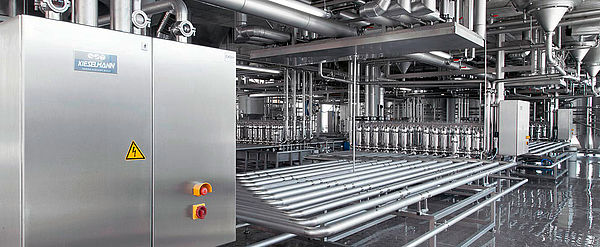Fully automated storage cellar at Doppelleu brewery
400 double-seat valves and 4000 running meters of support tubing are just a couple of the basic parameters taken from KIESELMANN Anlagenbau’s latest project. The fluid technology specialists out of Knittling, Germany, built a fully automated storage facility in 18 months for the Doppelleu Brauwerkstatt in Winterthur, Switzerland. The Swiss brewers, whose top-fermented craft beer brand “Chopfab” took off like a racehorse after launching an aggressive marketing campaign in 2012, were out of the gate well ahead of the competition.
Care for a “cool blond”, or perhaps a red, a black or a wheat beer? Whichever you choose, Doppelleu brewery’s Chopfab beers are stronger and slightly more exotic in taste than what you’re used to. In fact, what makes these craft beers so special and unique is that they are all top fermented. The brewery’s technical management team, Philipp Wagner and Patrick Thomi, are the ones responsible. By 2015, the demand for these beers was so great that an additional brewhouse and a new bottling plant had to be installed and taken into production.
Transparent showcase project
The fully automated storage cellar, completed in spring of 2017, is a prime example of a system without boundaries. “Doppelleu" currently produces 15 different beers with several different yeast strains. The plant processes all these different beers and strains fully automatically – and is also designed to adapt to further brews,” says Christian Ernst, Senior Project Manager for large-scale brewing projects at KIESELMANN Anlagenbau.
Mr. Ernst has already managed numerous large- scale projects, but calls the storage cellar in Winterthur the “most complete brewery project of the KIESELMANN Fluid Process Group” to date. For Ralf Haas, installation supervisor at KIESELMANN Anlagenbau, the automated storage cellar with full glass facade is unique in Switzerland: “Even in Germany, you’d have to search far and wide to find a system that is as flexible and has a comparable degree of automation. We’re talking about a plant that’s fully automated, requiring just one employee for a maximum of two hours daily. As a rule, one to two operators are employed full time on conventional systems with hose or swing bend manipulation panel technology.“
Under one umbrella
KIESELMANN Anlagenbau, together with KIESELMANN Fluid Process Group, acted as general contractor on this project. Assembly was carried out by four of the corporation’s eleven companies: KIESELMANN GmbH produced the valves and pipes, Rieger Behälterbau supplied the tanks, AquaDuna equipped the tanks with the cleaning assemblage and the KIESELMANN Anlagenbau team designed and managed the entire project. The Swiss brewers and the Swabian assemblers work well together.
“We’re constantly creating new beers – at least two a year so far. Therefore, it was crucial for us that the system is extremely flexible. In our first conversation with Christian Ernst it became instantly clear that we had found the perfect partner for this project: KIESELMANN,” says Doppelleu master brewer Patrick Thomi, regarding the relationship. The KIESELMANN Anlagenbau team specializes in outfitting breweries, which makes up more than 80 percent of all projects that the company handles.
“For us it was a huge advantage to have a central contact person in Christian Ernst, who consulted with us throughout the entire project, from the purchasing phase to the commissioning. This simplified communications during all construction phases, minimized our coordination efforts and optimized the project implementation overall,” says Patrick Thomi. Doppelleu’s technical management team delivered clear, ambitious specifications for the plant: They wanted a modular, standardized production plant in the cold-aseptic area that featured standardized hygienic procedures for tanks, pipework and other equipment. Optimizing yeast management in the areas of pure culture, propagation and strain storage was also a priority.






